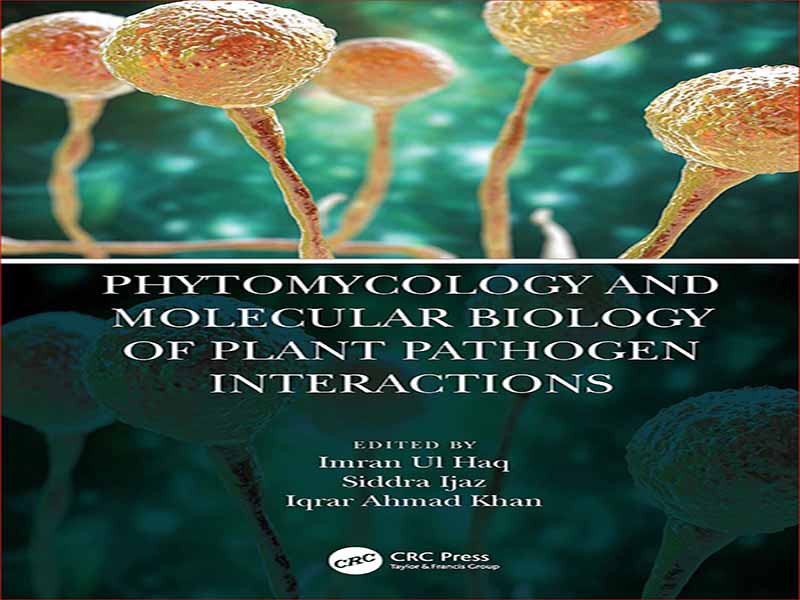- عنوان کتاب: Phytomycology and Molecular Biology of Plant Pathogen Interactions
- نویسنده: Imran Ul Haq, Siddra Ijaz, Iqrar Ahmad Khan
- حوزه: زیست شناسی مولکولی
- سال انتشار: 2022
- تعداد صفحه: 281
- زبان اصلی: انگلیسی
- نوع فایل: pdf
- حجم فایل: 7.31 مگابایت
طبیعت به قارچ ها توانایی تولید اسیدهای آلی، آنزیم ها و متابولیت های ثانویه و همچنین سنتز پروتئین را داده است و بنابراین از طریق مداخلات بیوتکنولوژیکی کاربردهای گسترده ای در صنایع غذایی و دارویی دارند. مهندسی متابولیک به عنوان یک رویکرد چند رشته ای و ابزاری قدرتمند برای بهینه سازی و معرفی فرآیندهای سلولی جدید ظهور کرده است. از نظر تاریخی، مطالعات بر روی میکروارگانیسمهای صنعتی – فرآیندهای متابولیسم اولیه، مسیرهای بیوشیمیایی و واکنشهای آنها. تعامل گیاه و میکروب اطلاعات زیادی در مورد این موضوع ایجاد کرد که به دانشمندان کمک کرد تا تحقیقات در مهندسی متابولیک را با استفاده از دادههای اخیر بهدستآمده از فناوریهای مدرن مانند پروتئومیکس، متابولومیک و ژنومیکس پیش ببرند. در سالهای اخیر، مهندسی ژنتیک جایگزینهای کارآمدتر و مؤثرتری نسبت به روشهای سنتی بهبود سویهها مانند جهشزایی و نوترکیبی ژنتیکی ارائه کرده است. این امر منجر به موفقیت زیادی در تولید تجاری پروتئین های مختلف قارچی شده است. پیشرفت در زیست شناسی مولکولی این امکان را فراهم کرده است که صفات مطلوب در سویه های قارچ کدگذاری شده توسط ژن های هترولوگ کشف شود. استراتژی های متعددی تا به امروز توسعه داده شده است که عملکرد ژن ها را بهبود می بخشد و محدودیت های بیان را کاهش می دهد. بهبود سویه به جداسازی بسیاری از ژن های صفات مورد نظر و در دسترس بودن جدایه های وحشی مربوط می شود. اخیراً، ژنهای بسیاری از سویههای قارچی شناسایی شدهاند که در ایجاد بیماری نقش دارند و علائم بیماری با قطع آنها تا حدی یا به طور کامل ناپدید میشوند. تکنیکهای جهشزایی برچسبگذاری شده برای شناسایی ژنهای بیماریزایی استفاده شدهاند. بسیاری از ژن های دخیل در تخریب دیواره سلولی، تشکیل ساختار عفونت، پاسخ به دفاع گیاه میزبان، تولید سموم و آبشارهای سیگنال شناسایی شده اند. علاوه بر این ژن ها، ژن های کاربردی جدید نیز شناسایی شده اند. ژن های مرتبط با بیماری زایی بیشتر را می توان با استفاده از تکنیک های مولکولی تجزیه و تحلیل کرد. این امر نتیجه ارتباط میزبان – میکروب را اشتباه میکند. نیاز زیادی به کشف یک سری رویدادهای سلولی مانند شبکه بسیار پیچیده میکروبهای ژنتیکی، فعل و انفعالات (میکروبی و متابولیک)، و رویدادهای سیگنال دهی درگیر در تعاملات متقابل میزبان- میکروب وجود دارد. در روابط متقابل، ریشه گیاهان یک همزیستی میکوریزی با قارچ های بازدارنده خاک ایجاد می کند. ریشه چنین گیاهانی باید قابلیت شناسایی شرکای قارچی را داشته باشد تا این تعامل برقرار شود. بر اساس این بررسی اجمالی از زیست شناسی مولکولی قارچی، ما سعی کرده ایم این کتاب را با فصل هایی طراحی کنیم که اطلاعات عمیقی در مورد جنبه های مختلف زیست شناسی مولکولی قارچی ارائه می دهد تا رابط گیاه – بیماری زا را کشف کند. این کتاب شامل 13 فصل است که موضوعات زیر را پوشش می دهد: سفر از اصول کخ تا زیست شناسی سیستم مولکولی. بینش به زیست شناسی قارچی؛ ژنوم قارچ و ژنومیک؛ ژن های بیماری زایی؛ مکانیسمهای مولکولی – پاسخهای دفاعی در گیاهان در برابر پاتوژنهای قارچی. بیان ژن قارچی و تعامل با گیاه میزبان؛ مداخلات بیوتکنولوژیک در بهبود سویه های قارچی؛ شناسایی مولکولی و تشخیص قارچ های گیاهی؛ زیربنای فیلوژنی و طبقه بندی قارچ های گیاهی از طریق زیست شناسی محاسباتی. کاربرد بیولوژی سیستم در تعامل گیاه و قارچ. رویکرد multiomics و تعامل گیاه و قارچ. مکانیسم مولکولی همزیستی میکوریزی؛ و مهندسی متابولیک قارچ های گیاهی برای کاربردهای صنعتی. این کتاب بینش های جامعی را در اختیار دانشجویان و محققانی قرار می دهد که به طور مستقیم یا غیرمستقیم در مطالعه زیست شناسی مولکولی گیاهان و قارچ های مرتبط با آن ها مشارکت دارند.
Nature has given fungi the ability to produce organic acids, enzymes, and secondary metabolites as well as bring about protein synthesis and thus have wide applications in food and pharmaceutical industries through biotechnological interventions. Metabolic engineering has emerged as a multidisciplinary approach and a powerful tool for optimizing and introducing new cellular processes. Historically, studies on industrial microorganisms—their primary metabolism processes, biochemical pathways, and reactions. Plant–microbe interaction generated a vast amount of information on the subject, which helped scientists advance the research in metabolic engineering using recent data obtained from modern technologies like proteomics, metabolomics, and genomics. In recent years, genetic engineering has provided more efficient and effective alternatives over traditional strain improvement methods such as mutagenesis and genetic recombination. This has resulted in great success in the commercial production of various fungal proteins. Advancement in molecular biology has made it possible to unravel the favorable traits in the strains of fungi encoded by heterologous genes. Numerous strategies have been developed to date, improving the functionality of genes and reducing the expression constraints. Strain improvement is related to the isolation of many genes of desired traits and the availability of wild isolates. Recently, many genes of fungal strains have been identified that are involved in disease development, and disease symptoms become partially or completely disappeared upon their disruption. Tagged mutagenesis techniques have been used for the identification of pathogenicity genes. Many genes involved in the degradation of the cell wall, infection structure formation, responses to host plant defenses, toxins production, and signal cascades have been identified. In addition to these genes, novel functional genes have also been identified. More pathogenicity-related genes can be analyzed by using molecular techniques. This confuses the outcome of host–microbe association. There is a great need to unravel a series of cellular events such as the highly complex network of genetic microbes, interactions (microbial and metabolic), and the signaling events involved in host–microbe interactions. In mutualistic relationships, the roots of plants form a mycorrhizal symbiosis with soil-inhibiting fungi. Roots of such plants must have the capability to detect the fungal partners to establish this interaction. On the basis of this overview of fungal molecular biology, we have tried to design this book with chapters that give in-depth information on various aspects of fungal molecular biology to unravel the plant– pathogen interface. This book comprises 13 chapters, which cover the following topics: journey from Koch’s postulates to molecular system biology; insight into fungal biology; fungal genome and genomics; pathogenicity genes; molecular mechanisms– relayed defense responses in plants against fungal pathogens; fungal gene expression and interaction with the host plant; biotechnological interventions in fungal strains improvement; molecular identification and detection of phytofungi; underpinning the phylogeny and taxonomy of phytofungi through computational biology; application of system biology in plant–fungus interaction; multiomics approach and plant–fungal interaction; the molecular mechanism of mycorrhizal symbiosis; and metabolic engineering of plant fungi for industrial applications. This book will provide comprehensive insights to students and researchers involved directly or indirectly in the study of the molecular biology of plants and their associated fungi.
این کتاب را میتوانید بصورت رایگان از لینک زیر دانلود نمایید.
Download: Phytomycology and Molecular Biology of Plant Pathogen Interactions


































نظرات کاربران